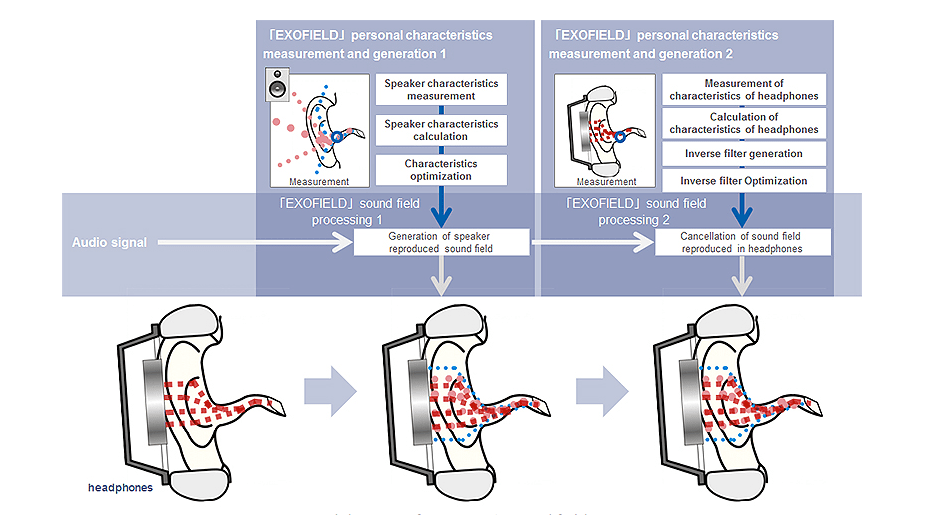It’s the time of year for saving money!
While many audiophiles embrace headphones as completely as room-based listening, another sector find the “in your head” imaging of headphones not as satisfying or involving as the imaging delivered by a room-based audio system. I’ve written in the past about the Smyth Brothers A-16 system and Darin Fong‘s “Out of Your Head” playback app, which are both solutions to the in-between-your-ears headphone “dilemma.” Now audiophiles have another potential way to reunite their headphone listening experience with room-based locational cues.
 The JVCKENWOOD Exofield system was introduced over a year ago, originally in Japan. The system consists of two primary parts. The first part entails measurement, then the data is processed into a form that can be used in a smartphone app to personalize and create an out-of-head listening experience. At the 2018 Axpona show I had an opportunity to experience a demonstration of this new technology. I was impressed with Exofield’s ability to mimic the sonics of the room-based system that was used for the demo. Let me walk you through the process.
The JVCKENWOOD Exofield system was introduced over a year ago, originally in Japan. The system consists of two primary parts. The first part entails measurement, then the data is processed into a form that can be used in a smartphone app to personalize and create an out-of-head listening experience. At the 2018 Axpona show I had an opportunity to experience a demonstration of this new technology. I was impressed with Exofield’s ability to mimic the sonics of the room-based system that was used for the demo. Let me walk you through the process.
Like the Smyth system (which I’ve experienced many times) the first step in the Exofield process is to measure stuff. In Exofield’s case the stuff is measured by a specially developed yoke microphone array that places tiny microphones at the openings of your ear canals. The yoke is designed so stay in place while multiple measurements are made, both free air and with headphones in place. The first test (which sound like a series of clicks) measures the response to the loudspeaker system. Next the same tests are conducted with headphones in place. Then a third set of tests are done with the headphones off. After the three tests it only took a minute or so for the system to develop its playback parameters.
 During the listening comparison part of this demonstration I was impressed by how little difference there was between the Exofield processed headphone sonics and the room’s original sound. Unlike the Darin Fong system, where the imaging, even with the best plug-in, was not as specific as what can be obtained from a real loudspeaker system, the Exofield system’s imaging was just as tight and well-defined as the room-based system it modeled.
During the listening comparison part of this demonstration I was impressed by how little difference there was between the Exofield processed headphone sonics and the room’s original sound. Unlike the Darin Fong system, where the imaging, even with the best plug-in, was not as specific as what can be obtained from a real loudspeaker system, the Exofield system’s imaging was just as tight and well-defined as the room-based system it modeled.
As of today, the Exofield system has not be released in the US yet, and it needs to have several large issues ironed out before it becomes a real-world product. First there is the question of WHO and WHERE the initial tests will be done. JVCKENWOOD has not decided whether to partner with brick and mortar specialist audio retailers or audiologists, or both. One this is clear from my demo – the Exofield system requires an experienced person to place, measure, and do the data compilation to create the final smartphone app. During my demo it quickly became obvious that accurate microphone placement is critical for optimum app performance and that is was easy for the mics to move during the testing process.
 While the Exofield shares some similarities with the Smyth system, in that it requires measurement of a room, and can model particular speaker systems and rooms, it does not deliver any of the head-tracking functions (when you move your head with the Smyth system the phantom speakers seem to stay in place, with the Exofield system the speaker image isn’t anchored in modeled space – the speakers always appear to come from in front regardless of whether you turn your head).
While the Exofield shares some similarities with the Smyth system, in that it requires measurement of a room, and can model particular speaker systems and rooms, it does not deliver any of the head-tracking functions (when you move your head with the Smyth system the phantom speakers seem to stay in place, with the Exofield system the speaker image isn’t anchored in modeled space – the speakers always appear to come from in front regardless of whether you turn your head).
One major difference between the Exofield technology and previous headphone-altering apps, is the Exofield is aimed specifically at smartphones. Currently the Smyth and Darin Fong apps are tied to room-based rather than smartphone-based systems. Adding complete portability to the room-simulation app vastly expands not only its market, but also its potential for interface with other mobile applications.
Yes, Exofield is not yet ready for prime time. But, when and if it does blossom into a real-world product Exofield could be one of those “paradigm changing” technological advances that all us technophiles love/hate. Only time will tell…and in the meantime here’s a link to a JVCKENNWOOD’s press release about Exofield. If you read it very slowly by the time you finish it could be a real product…








